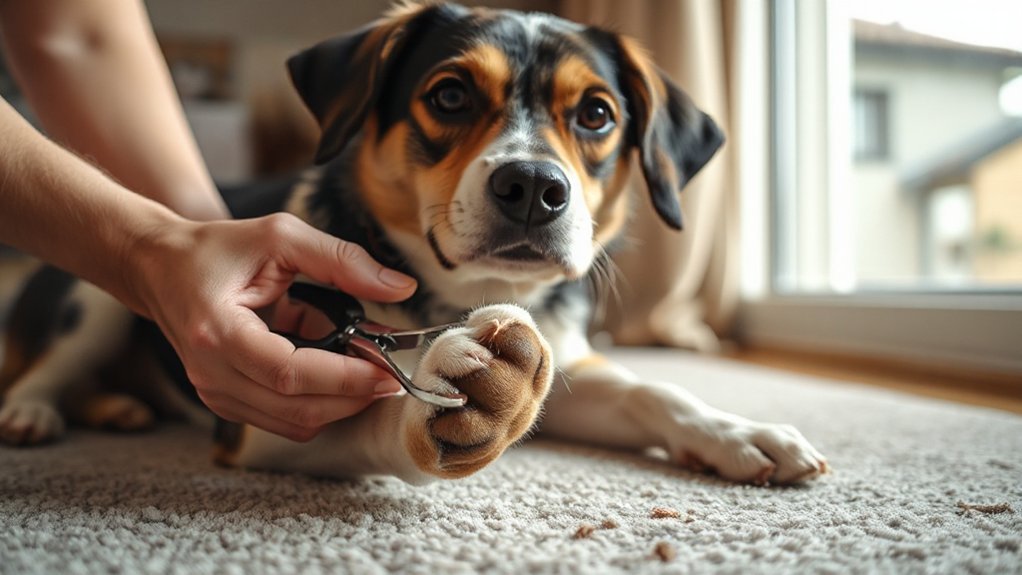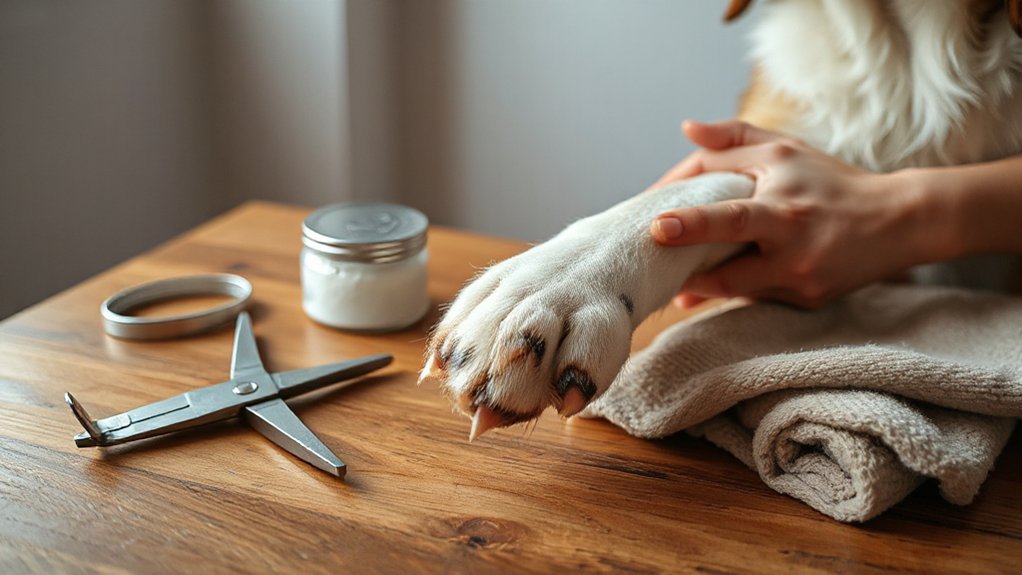You’ll want to trim your dog’s nails regularly to prevent discomfort and joint strain, and you can do it safely with the right tools and technique. Start by inspecting the nails, learning to see the quick, and choosing a calm, well-lit spot. Use sharp clippers or a grinder, stabilize the paw, and take off small amounts to avoid bleeding. Keep sessions short and reward calm behavior — here’s exactly how to proceed.
Key Takeaways
- Inspect nails weekly, identify the quick (visible in light nails; trim conservatively on dark nails), and adjust frequency to activity level.
- Use appropriate tools—sharp scissor/guillotine clippers or a rotary grinder—and keep styptic powder/cornstarch nearby for bleeding.
- Hold the paw firmly, extend the nail, and make small perpendicular cuts at the tip, checking the cross-section after each snip.
- Keep sessions short, calm, and reward immediately with high-value treats to desensitize and reinforce cooperative behavior.
- If you cut the quick, apply direct pressure and styptic powder, stop the session, document the incident, and resume later calmly.
When and How Often Should You Trim Your Dog’s Nails?

Although activity level and nail growth vary by dog, you should check and trim nails regularly on a predictable schedule. You’ll inspect nails every one to two weeks to assess length, wear, and quick position. For active dogs that wear nails naturally, you may follow a two- to four-week nail trimming schedule; less active or indoor dogs typically need trimming every one to two weeks. Nail care frequency depends on breed, age, and gait; adjust based on visual cues—if nails touch the ground or cause splaying, shorten sooner. Keep records of dates and outcomes so you maintain consistency and reduce risk of overgrowth or injury. When in doubt, err toward more frequent, conservative trims and consult your veterinarian.
Tools You Need for Safe Nail Trimming

You’ll need the right cutting tools—scissor or guillotine clippers—so you can match blade style to your dog’s nail size and thickness. Consider a rotary grinder as an alternative for smoothing edges or tackling sensitive quicks, and pick a low-noise model if your dog startles easily. Keep styptic powder or cornstarch and basic first-aid supplies on hand to control bleeding and prevent infection if you nick the quick.
Nail Clippers Types
Choosing the right clippers makes nail trimming safer and quicker for both you and your dog. You’ll choose between scissor clippers and guillotine clippers based on nail size and your control. Scissor clippers resemble small shears and deliver a straight, powerful cut for thicker nails; they require firm handling and precise placement. Guillotine clippers have a stationary ring and a sliding blade that slices the tip, offering cleaner cuts for small-to-medium nails and timid animals. Choose sharp, sturdy steel blades and ergonomic grips to reduce slipping and crushing. Avoid cheap, flexible blades that splinter nails. Match clipper type to your dog’s nail thickness and your steadiness. Keep them clean, dry, and sharpened for consistent, safe results.
Grinding Tools Options
If clippers feel awkward or risk splitting, grinders offer controlled shaping and smoother edges. You’ll choose between rotary and drum-style grinding tools; both remove keratin gradually so you can monitor length precisely. Look for variable speed, low-vibration motors, and ergonomic grips to reduce noise and hand fatigue. Use coarse bits for rapid reduction and finer bits for finishing; replace worn bits to maintain effectiveness. Battery-powered units prioritize portability, corded units supply consistent torque. Consider dust collection or use a damp cloth to manage filings. Nail grinders are effective for thick or dark nails where quick cuts risk hitting the quick. Train your dog to accept the sound and sensation with short, progressive sessions for reliable, safe grooming outcomes.
Safety and First-Aid
A few essential items will keep you prepared for common trimming emergencies and reduce risk during routine nail care. You’ll need sterile styptic powder or pencil to stop bleeding quickly if you nick the quick, and absorbent gauze to apply firm pressure. Keep antiseptic wipes to clean any small wounds and a flashlight to clearly visualize the quick during nail trimming. Use properly sized clippers or a grinder with guarded tips to minimize accidental cuts. Have a muzzle or slip lead available if your dog becomes reactive; use them only as a safety measure, not punishment. Store a basic first-aid kit with bandages, tweezers, and your veterinarian’s phone number. Regularly check and replace supplies to maintain injury prevention readiness.
How to Identify the Quick and Avoid Cutting It

Many dogs have a visible quick in light-colored nails, but you can still identify it in dark nails by looking for the blood vessel’s soft, slightly translucent region near the base; avoid cutting into this area by trimming small amounts from the tip and checking the cross-section for a faint gray or pink oval that indicates proximity to the quick. For quick identification, understand basic nail anatomy: the hard keratin shell, the inner pulp with capillaries and nerve endings, and the quick running longitudinally toward the nail bed. Work in good light, extend the toe to expose curvature, and inspect for a rounded darker core. Trim conservative increments and recheck the exposed cross-section after each cut. If uncertain, stop and consult a veterinarian or groomer.
Step-By-Step Guide to Trimming Your Dog’s Nails With Clippers
Start by preparing your workspace and your dog so you both stay calm and steady; sit where you can support the paw, have clippers, styptic powder, and treats within reach, and work in good light. Hold the paw firmly but gently, extend the nail, and inspect the quick visually. Position clippers perpendicular to the nail, avoid crushing cuts, and use short, controlled snips. Trim only the tip, check after each cut, and stop if you see a dark dot or a pink center. Reward your dog between nails to reinforce calm behavior. If bleeding occurs, apply styptic powder promptly and maintain pressure. These nail trimming techniques belong to dog grooming essentials; practice regularly to reduce stress and improve accuracy.
How to File Your Dog’s Nails Instead of Cutting
One simple alternative to clippers is to file your dog’s nails, which reduces the risk of cutting the quick and lets you shape nails gradually. You’ll need a proper file or rotary tool, a non-slip surface, and restraint—preferably a helper. Begin with short sessions to build tolerance. Hold the paw firmly but calmly, support the toe, and file in one direction away from the quick. Use controlled, light strokes; check length frequently. Focus on shape and smooth edges rather than aggressive shortening. Incorporate nail care into routine grooming to prevent overgrowth. If the nail has a dark appearance, proceed even more cautiously and shorten incrementally. Clean the filing tool after use. Praise your dog and stop if you see bleeding or severe distress.
What to Do if You Accidentally Cut the Quick
If you accidentally hit the quick while trimming or filing, act quickly and calmly to control bleeding and pain. Apply direct pressure with sterile gauze for several minutes; avoid peeking repeatedly. If bleeding continues, use a styptic powder, pencil, or cornstarch pressed firmly into the nail tip to clot; maintain pressure for a minute after application. Keep the paw elevated and still until bleeding stops. Clean the area with a mild antiseptic once controlled, then monitor for swelling, prolonged oozing, or limping. Offer a quiet reward to reassure your dog. Document the incident to adjust future nail care and avoid the same angle or length. Seek veterinary care if bleeding persists beyond 20–30 minutes, if the wound looks infected, or if your dog shows severe pain.
Tips to Keep Your Dog Calm and Cooperative During Grooming
Set a calm, predictable routine so your dog knows what to expect before you begin. Use firm, consistent positive reinforcement—treats and calm praise—to reward compliance. Keep sessions short and gradual, increasing duration only as your dog remains relaxed.
Establish a Calm Routine
When you create a predictable, low-stress grooming routine, your dog learns what to expect and is less likely to resist; consistent timing, quiet space, and brief positive sessions build trust and cooperation. You’ll set a calm environment and use basic soothing techniques to reduce arousal before you handle paws. Keep sessions short, end them before fatigue, and maintain the same location and sequence so the dog forms a reliable association.
- Schedule sessions at the same times to normalize the procedure.
- Use a quiet room and controlled lighting to minimize triggers.
- Introduce handling steps incrementally, increasing duration only when relaxed.
Be deliberate, observe body language, and stop if stress markers rise. Repeat until the routine is automatic and predictable.
Use Positive Reinforcement
Positive reinforcement lets you shape calm, cooperative behavior by rewarding desired responses immediately and consistently; use high-value treats, short praise, and brief breaks to mark relaxed paw handling and successful trims. You’ll apply reward based training principles: reinforce a calm posture, a lifted paw, and tolerance for clippers. Deliver rewards within one second so the dog links the behavior and outcome. Use varied, high-value rewards to prevent satiation and maintain motivation. Pair handling with neutral stimuli to build positive associations to tools and touch. Avoid punishment or raised voices; they undermine trust and increase avoidance. You’ll track responses, escalate rewards for progress, and with consistent, contingent reinforcement you’ll reduce stress and increase cooperative behavior during nail care.
Take Gradual Short Sessions
Reinforcement works best in short bursts, so keep nail sessions brief and focused to preserve the positive associations you’ve built. You’ll use short sessions and gradual exposure to desensitize your dog without triggering stress. Limit each attempt to a few minutes, stop while your dog remains calm, and increase duration only after consistent success. Use clear, neutral handling and immediate rewards for compliance. Track progress objectively: time tolerated, number of nails, and stress signs. Consistency matters more than length.
- Begin with handling paws only, no clippers.
- Progress to touching clippers, then trimming one nail.
- Extend session length only when calm behavior is repeatable.
This controlled protocol minimizes resistance and builds reliable grooming tolerance.
Special Considerations for Puppies, Seniors, and Thick or Dark Nails
Although the basic trimming technique is the same, puppies, senior dogs, and nails that are thick or dark each require specific adjustments to keep the procedure safe and effective. For a puppy nail, you’ll introduce clipping slowly, use small, frequent sessions, and reward calm behavior to build tolerance; their quick is closer to the tip, so trim minimally. In senior care, assess for arthritis, limited mobility, or brittle nails; stabilize the limb, support the dog, and trim shorter, more often, to avoid cracks. With thick nails, use a grinder or make incremental cuts to prevent splitting. For dark nails, trim cautiously in small increments since the quick is hidden; stop at frequent checks for a dull, gray center. Always have styptic nearby.
Conclusion
Regularly inspect and trim your dog’s nails every 1–2 weeks or as needed to prevent overgrowth and discomfort. Use sharp, appropriate clippers or a file, stabilize the paw, and trim small amounts while avoiding the quick—look for translucence or trim conservatively on dark nails. Reward calm behavior, keep sessions brief, and adjust technique for puppies, senior dogs, or thick nails. If you cut the quick, apply pressure and styptic powder; seek veterinary care for severe bleeding.